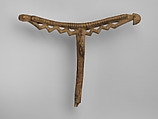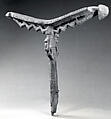Staff and Stool (Dolaba)
Not on view
A special type of staff called dolaba is held by all the male participants in the sigi ceremony, a rite held every sixty years to commemorate the myth of the origin of death among the Dogon.
During the many processions and dances that take place during the three weeks that sigi is celebrated in each region, the T-shaped staffs are held in the left hand; they are also used as seats during the frequent beer-drinking parts of the ceremony.
After the sigi is completed, the dolaba is saved until the death of its owner. When a man's final commemorative ceremony is celebrated, his dolaba is removed from his house and transferred to a rock shelter, just as the man's soul is ritually transported to its final resting place outside the village. The dolaba seems to represent the man's full participation in rituals essential to his community.
Dolaba made for olubaru, or initiates of the Dogon men's mask society, are said to be more ornate than those of ordinary participants. (Very few Dogon men are actually initiated, although all men participate in the rituals associated with the masks.) This example is particularly elaborate in its iconography, with a human figure carved in relief on each side of the shaft and a snake-like openwork zigzag carved below the seat, each end of which terminates in a human head (one of the heads in this example has been lost). The entire staff-seat has been covered with sacrificial materials, which may include chicken blood, sesame and sa oil, red plant dye, and red earth. The nyama, or vital force, contained in these ingredients passes through the dolaba to the person who sits upon it and accounts for the great increase in spiritual energy experienced by a person who has participated in this most important and difficult of Dogon rituals.
Due to rights restrictions, this image cannot be enlarged, viewed at full screen, or downloaded.
This artwork is meant to be viewed from right to left. Scroll left to view more.




